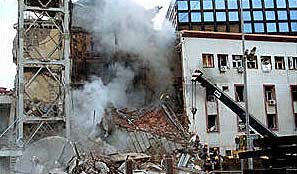The Newspeak Newseum
On April 11, 2008, the inelegantly named Newseum opened in Washington, DC., to great fanfare. Ostensibly created to celebrate journalism in America and beyond, the seven-story museum is the newest and most expensive museum in the United States. Founded by the Freedom Forum and costing $450 million, the latest cultural institution to be added to the nation’s capital is so far receiving rave reviews from the press, but things are never quite what they seem – especially in a city like Washington, DC.
Let’s start with the name, “Newseum”, which sounds remarkably like a word from “Newspeak”, the fictional language from 1984, George Orwell’s novel about a totalitarian society. The function of Newspeak was to significantly decrease the number of words in the English language, thereby purging meaning and ideas dangerous to totalitarian rule. For example, in Orwell’s novel the Ministry of Truth (“Minitru” in Newspeak), was the government agency in charge of manufacturing news, entertainment, art, and educational materials. Its primary functions entailed the falsification of history and the concoction of the “truth”. We’re hearing a lot of Newspeak-like words these days, and “Newseum” is one of them – it’s an unseemly name for an important museum.
One can learn more about the state of journalism in America today by examining the complicated financial ties, holdings, mergers, and acquisitions of corporate media than by strolling through the Newseum. The Newseum’s roster of “partners” is a veritable list of the cartels that dominate America’s media, and the museum’s founding organization, Freedom Forum, itself has ties to Gannett Co., Inc., which owns USA Today – the largest selling newspaper in the U.S., as well as 84 other newspapers, 1,000 non-daily publications, 23 television stations, and 130 web sites. The Newseum insists their partners have no control over the museum’s content or direction, but each has contributed anywhere from $5 million to $15 million to the museum, and with wings like the “Time Warner World News Gallery” and the “ABC News Changing Exhibits Gallery” – it’s difficult not to see the Newseum as one big advertisement for corporate media giants.
The concentrated power of the companies backing the Newseum can be illustrated by glancing at the portfolios of just two of the museum’s financial backers. News Corporation owns the Fox Broadcasting Company, Fox News Channel, 20th Century Fox Film, and 176 newspapers. Time Warner is the largest media conglomerate in the world, and its holdings include CNN, HBO, Cinemax, Cartoon Network, TNT, America Online, Mapquest, Netscape, Warner Bros. Pictures, and over 150 magazines including Time and People. The operative word at the Newseum seems to be – monopoly.
The Newseum promotes itself as “the most interactive museum in the world”, but it appears this interactivity could be more about shaping public opinion than it is in providing museum goers with an outstanding educational experience regarding journalism. A case in point; ABC’s flagship public affairs show, This Week with George Stephanopoulos, will begin broadcasting from one of the museum’s multi-media studios on April 20, 2008. This raises some interesting questions, especially since ABC is one of the Newseum’s major financial partners. On April 10, 2008, U.S. Commander in Iraq General David Petraeus, along with U.S. Ambassador to Iraq, Ryan Crocker, held a news conference at the Newseum where they defended U.S. military efforts in Iraq. It’s difficult to imagine the Newseum opening its multi-media studios to war opponents, who are also worthy news makers.
The role of the corporate press in beating the drums of war for the Bush administration was the subject of Buying the War, a devastating documentary by Bill Moyers and Kathleen Hughes (watch the entire film on the Bill Moyers Journal website). Mr. Kurtz appeared in Moyers film, where he stated: “From August 2002 until the war was launched in March of 2003 there were about 140 front page pieces in The Washington Post making the administration’s case for war, but there was only a handful of stories that ran on the front page that made the opposite case. Or, if not making the opposite case, raised questions.” Washington Post staff writer Tom Shales reviewed the 90-minute Moyers report, saying that it convincingly told the story of how “the media abandoned their role as watchdog and became lapdog instead.” At the Newseum, the same media conglomerates that disseminated the deceptions that led America to war, now promote themselves as the guardians of a free press and the very pinnacle of professional journalism.
The Newseum was founded by the Freedom Forum, which touts itself as a “nonpartisan foundation dedicated to free press, free speech and free spirit for all people.” Formerly vice president of news and communications at Gannett Co., Inc., Charles L. Overby was the chairman and chief executive officer of the Freedom Foundation, as well as CEO of the Newseum, until he was replaced by Jan Neuharth in Dec. 2001 (Ms. Neuharth is the eldest daughter of Al Neuharth, the founder of the Freedom Foundation).
Overby also holds a commanding position in another organization that seems a far cry from the world of journalism and press freedom – a powerful position that was not listed on his bio at the Newseum website. Overby sits on the Board of Directors for the Corrections Corporation of America (CCA), the largest privately-run, for profit prison system in the United States. According to the CCA website, it is also one of the “largest prison operators” in America, running “63 facilities, including 38 company-owned facilities, with a total design capacity of approximately 67,000 beds in 19 states and the District of Columbia.” CCA also runs the T. Don Hutto family detention center in Taylor, Texas, for the Department of Homeland Security – the first detention camp in America specifically designed to hold immigrant men, women, and children who have not been charged with any crimes.
Journalist Russ Baker’s 2002 article, Cracks in a Foundation: The Freedom Forum Narrows its Vision, reveals how the Freedom Forum made severe cuts to its well regarded journalism grants and programs, allowing it “to concentrate on its jewel, the Newseum.” The eliminated grants, Baker wrote, had lent “succor to foreign journalists struggling in some of the world’s toughest arenas. The overseas operation – with offices in Johannesburg, London, Hong Kong, and Buenos Aires – would be shut down in its entirety.” Baker’s article quoted the former director of the Freedom Forum’s European Center in London, John Owen: “The people who run the Freedom Forum, I am ashamed to say, betrayed the commitments they made all over the world to support the cause of free and independent journalism. The irony is that in order to construct a new, expensive, state-of-the-art facility in Washington, we have shut down other buildings and evicted the very people that someday this Newseum will be honoring for their journalism.”
On public display at the Newseum are a number of historic artifacts pertaining to the history of journalism and press freedom – some of which make for thoughtful, interesting, and sometimes profound selections. However, the collection is as significant for what it includes as for what it excludes. To my knowledge, the Newseum makes no mention of the U.S. bombing of Radio Television Serbia (RTS) during the Kosovo war of 1999, when President Clinton and his NATO allies launched an air war against Serbia in order to force Serbian troops out of Kosovo. Whatever one may think of that war and the role America played in it, it seems a travesty that the Newseum would ignore the deliberate aerial bombing of a modern television station and the deaths of the civilian staff who occupied it.

On April 23, 1999, an American cruise missile slammed into the RTS building in downtown Belgrade at 2 a.m., killing 16 civilian TV technicians working at the station – including a 27-year-old make-up woman. The U.S. and NATO argued that the station was a legitimate military target because it broadcast propaganda, but according to journalist Robert Fisk of the Independent who was at the scene of the bombing as the bodies were being pulled from the smoldering rubble, “Once you kill people because you don’t like what they say, you change the rules of war.” Amnesty International issued a scorching condemnation of the attack on RTS, stating that: “NATO deliberately attacked a civilian object, killing 16 civilians, for the purpose of disrupting Serb television broadcasts in the middle of the night for approximately three hours. It is hard to see how this can be consistent with the rule of proportionality.”
While the Newseum includes examples of media blunders, gaffes, and outright lies hoisted upon an unsuspecting public, they apparently could not find exhibit space for an alarming news story from the year 2000, when officers from the U.S. Army 4th Psychological Operations Group (PSYOPS) were invited to work in the news divisions of CNN and National Public Radio during the waning days of the Kosovo War. The story first surfaced in the Netherlands where the Amsterdam daily newspaper Trouw published the report. The article was translated into English but was picked up only by a handful of publications. One such periodical was the British daily, The Guardian, which wrote on April 12, 2000;
“For its part, the army said the program was only intended to give young army media specialists some experience of how the news industry functioned. The interns were restricted to mainly menial tasks such as answering phones, but the fact that military propaganda experts were even present in newsrooms as reports from the Kosovo conflict were being broadcast has triggered a storm of criticism and raised questions about the independence of these networks.”
Both CNN and NPR admitted they allowed PSYOPS personnel to work in their news department headquarters, but insisted the officers were only interns who had no influence over news production. The American media watchdog group, Fairness & Accuracy In Reporting (FAIR), wrote; “Even if the PSYOPS officers working in the newsroom did not influence news reporting, did the network allow the military to conduct an intelligence-gathering mission against CNN itself? (….) FAIR commends CNN for acknowledging that the presence of PSYOPS personnel in the newsroom was, in its words, ‘inappropriate.’ It is unfortunate that the network came to that conclusion only after the program’s existence was revealed in February by the Dutch newspaper Trout.”
The traditional concept of a museum as an elite institution dedicated to research and the acquisition, conservation, and safeguarding of humanity’s collective heritage – seems to be giving way to a profit driven, entertainment oriented, glitzy pop culture approach to museum management. As corporate monopolies move ever closer to controlling the cultural life of the nation, the Newseum provides the clearest look yet of a cultural institution in the service of big business.




